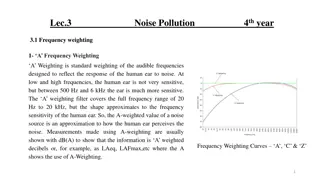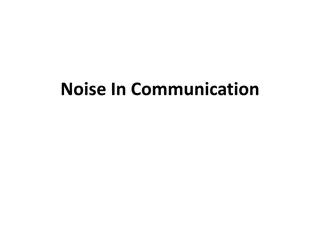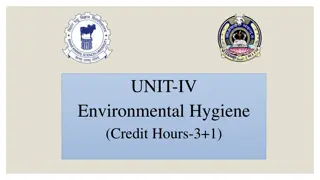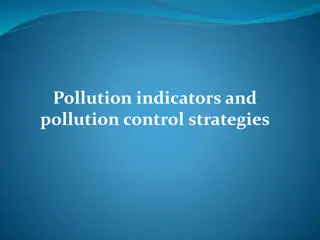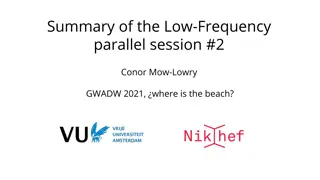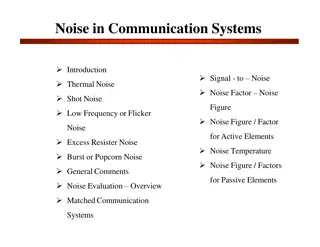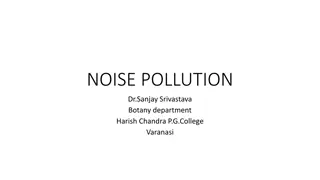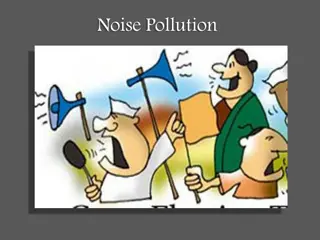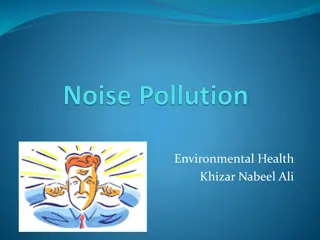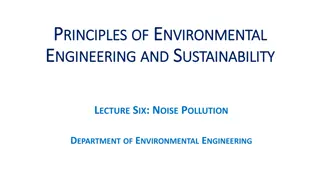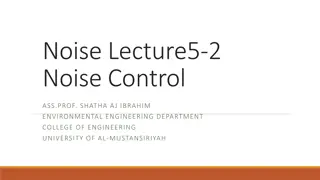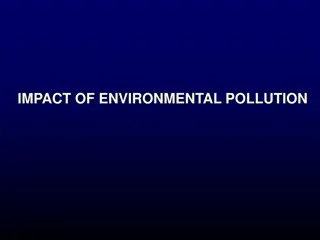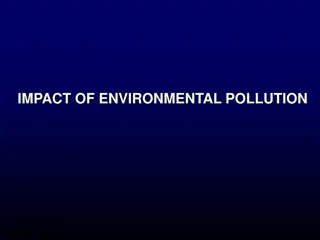Environmental Effects of Noise Pollution on Human Health
When a sound wave enters the ear, it sets off a chain reaction that can lead to various health issues such as depression, fatigue, insomnia, and decreased cognitive function. Noise pollution affects individuals at different levels - auditory, biological, and behavioral, impacting performance, physiology, and psychology. Understanding the hearing threshold levels is essential in evaluating the impact of noise exposure on hearing sensitivity. Factors such as sound level, frequency distribution, duration of exposure, and individual tolerance levels play a crucial role in determining the effects of noise on human health.
Uploaded on Oct 11, 2024 | 0 Views
Download Presentation

Please find below an Image/Link to download the presentation.
The content on the website is provided AS IS for your information and personal use only. It may not be sold, licensed, or shared on other websites without obtaining consent from the author.If you encounter any issues during the download, it is possible that the publisher has removed the file from their server.
You are allowed to download the files provided on this website for personal or commercial use, subject to the condition that they are used lawfully. All files are the property of their respective owners.
The content on the website is provided AS IS for your information and personal use only. It may not be sold, licensed, or shared on other websites without obtaining consent from the author.
E N D
Presentation Transcript
Lec.5 Noise Pollution 4thyear The Environmental Effects of Noise 5.1 The Ear When a sound wave enters the ear, it sets the eardrum into oscillation, which in turn causes oscillation of the three tiny bones in the middle ear called the ossicles, Fig.5.1. This oscillation is finally transmitted to the fluid-filled inner ear, the motion of the fluid disturbs hair cells within the inner ear, which transmit nerve impulses to the brain with the information that a sound is present. The moving part of the eardrum has an area of about 43mm2, and the area of the stapes (the smallest of the ossicles) where it connects to the inner ear is about 3.2mm2. The speed of sound in this fluid is about 1500m/sec. Fig.5.1 Anatomy of the ear 1
Noise has been found to interfere with our activities at three levels: a) Audio logical level in referring with the satisfactory performance of the hearing mechanism b) Biological level interfering with the biological functioning of the body c) Behavioral level affecting the sociological behavior of the subjects. Because of this , the noise affects categorically, performance, physiology and psychology. Various psychological effect of noise pollution are summarized below: 1. Depression and fatigue, which considerably reduces the efficiency of a person 2. Insomnia as a result of lack of undisturbed and refreshing sleep 3. Straining of senses and annoyance as a result of slow but persistent noise from alarm clocks, call bells, telephone rings..etc. 4. Affecting of psychomotor performance of a person by a sudden loud noise 5. It is a cause of frustration and is associated with difficulty in concentration, disturbance of rest, physical and mental fatigue. 2
5.2 Hearing Threshold Level A measured threshold of hearing, expressed in dB relative to a specified standard of normal hearing. Obviously, any measurement of threshold shift is dependent upon having a baseline audiogram taken before the noise exposure. Hearing loss may be either temporary or permanent. Noise induced losses must be separated from other causes of hearing loss such as age, drugs, disease and blows on the head. Temporary threshold level, when a person of normal hearing is exposed to intense noise for a few hours, he suffers a temporary loss of hearing sensitivity. Permanent threshold level, in the case of someone exposed to intense occupational noise during the working day for a matter of years, the stage is often reached where the temporary threshold shift has not completely recovered overnight before the next exposure. Important variables in the development of temporary and permanent hearing threshold changes include the following: 1. Sound level: Sound levels must exceed 60 to 80dB(A) before the typical person will experience TTS 2. Frequency distribution of sound: sounds having most of their energy in the speech frequencies are more potent is causing a threshold shift than are sounds having most of their energy below the speech frequencies. 3
3. Duration of sound: the longer the sound lasts, the greater the amounts of threshold shift. 4. Temporal distribution of sound exposure: the number and length quite periods of sound influences the potentiality of threshold shift. 5. Individual differences in tolerance of sound may vary greatly among individuals. 6. Type of sound, steady state, intermittent, impulse or impact: the tolerance to peak sound pressure is greatly reduced by increasing the duration of the sound. Other Effects: Tinnitus, or "ringing in the ears," can occur after long-term exposure to high sound levels, or sometimes from short-term exposure to very high sound levels, such as gunshots. Many other physical and physiological conditions also cause tinnitus. Regardless of the cause, this condition is actually a disturbance produced by the inner ear and interpreted by the brain as sound. Individuals with tinnitus describe it as a hum, buzz, roar, ring, or whistle, which can be short term or permanent. Acoustic trauma refers to a temporary or permanent hearing loss due to a sudden, intense acoustic or noise event, such as an explosion 4
Other consequences of excessive workplace noise exposure include interference with communications and performance. Workers might find it difficult to understand speech or auditory signals in areas with high noise levels. Noisy environments also lead to a sense of isolation, annoyance, difficulty concentrating, lowered morale, reduced efficiency, absenteeism, and accidents. In some individuals, excessive noise exposure can contribute to other physical effects. These can include muscle tension and increased blood pressure (hypertension). Noise exposure can also cause a stress reaction, interfere with sleep, and cause fatigue. 5
5.3 OSHA Noise Exposure Standard Noise exposure standard consists of a 2-stage program : 1. Hearing conservation measures become mandatory at 85dBA for an 8-hr /day. Hearing conservation programs include annual audiometric testing and provision of hearing protectors. 2. Engineering or administrative noise controls are required when exposures exceed 90dBA for an 8-hr/day. Engineering controls include reducing machinery noise through redesign, replacement with quieter equipment or by reducing the transmission of noise along the path from source to receiver including enclosing the noise source or noise receiver. Administrative controls include reducing noise exposure by limiting the time an employee is exposed to given noise levels. This standard is designed to protect general industry workers, such as those working in the manufacturing, utilities, and service sectors. The General Industry standard establishes permissible noise exposures, requires the use of engineering and administrative controls, and sets out the requirements of a hearing conservation program. 6
The general industry noise standard contains two noise exposure limit tables. Each table serves a different purpose: Table 1(G-16) : This table applies to the engineering and administrative controls section, which provides a 90-dBA criterion for an 8-hour TWA ( time-weighted average) and is measured using a 90-dBA threshold (i.e., noise below 90 dBA is not integrated into the TWA). This table limits short-term noise exposure to a level not greater than 115 dBA (for up to 15 minutes). OSHA s Table G-16 Sound Level, slow response (dBA) 85 90 92 95 97 100 102 105 110 115 Duration per day (hours) 16 8 6 4 3 2 1.5 1 0.5 0.25 7
OSHAs Table G-16A Table 2(G-16A): This table, presented A-weighted sound level, L (decibel) Reference duration T (hour) in Appendix A of 29 CFR 1910.95, 80 32 81 27.9 provides information (e.g., reference 82 83 84 85 24.3 21.1 18.4 16 durations) useful for calculating TWA exposures when the workshift noise 86 13.9 exposure is composed of two or more 87 12.1 88 10.6 periods of noise at different levels. 89 90 91 92 93 9.2 8 7 6.1 5.3 Although this table lists noise levels exceeding 115 dBA, these listings are only intended as aids in calculating 94 4.6 95 96 97 98 99 100 4 TWA exposure levels; the listings for 3.5 3 2.6 2.3 2 higher noise exposure levels do not imply that these noise levels are acceptable. ..130 .0.031 8
Typically, workers may be exposed to different noise levels during the course of an eight-hour shift. To calculate the dosage in such scenarios, the partial times at the different sound levels would be added up. The following formula can be used to determine the percent dose for a day with different sound levels: D The percentage dose Cn The actual hours at a certain sound level Tn The allowable time for that sound level (from Table G-16) 9
As an example, we can calculate the percentage dose for a worker who is exposed to 4 hours of 90 dBA and 4 hours of 85 dBA: This dose (75%) is acceptable since it is less than or equal to 100%. For sound levels not listed on the chart, the following formula can be used to determine the allowable time T in hours: 90 ? 5 ? = 8 2 To determine the allowable exposure to 96 dBA, we would calculate as follows: 10
Time-Weighted Average (TWA) TWA is another way to consider dose. The TWA is given in dBA, and shows the exposure as an 8-hour day at a constant sound level rather than as a percentage of the maximum level allowed. For example, a 50% dose is equivalent to a TWA of 85 dBA. To convert from percentage dose (D) to TWA, the following formula can be used: ? ??? 90 + 16.61 ??? 100 A dose of 79% would be equivalent to a time-weighted average of about 88.3 dBA. This is calculated as follows: A dose of 79% would be equivalent to a time-weighted average of about 88.3 dBA. This is calculated as follows: 11
Putting the Formulas to Work Let s say that you work in a factory and throughout the day you deliver raw materials to different departments. Throughout the day you are exposed to a variety of noise levels. Let s use the following noise levels to determine your overall exposure to noise during your workday: 2 hours at 84 dBA 1.5 hours at 96 dBA 2.5 hours at 73 dBA 1.5 hours at 99 dBA 0.5 hours at 68 dBA First, we need to calculate the allowable times for an 8-hour day at these different sound levels. None of these dBA values is on the chart, so we can use the formula from above to calculate the allowable times: 12
Doing the math will determine the following times (T), in hours: Sound Level, slow response (dBA) 84 96 73 99 68 Duration per day (hours) 18.4 3.5 84.4 2.3 168.9 Now we need to sum these up using the formula: This dose is greater than 100%, so this is unacceptable, and measures must be taken to reduce the worker s exposure. 13
To calculate the equivalent sound level of this dose, we can calculate the TWA as follows: The above scenario is equivalent to the worker being exposed to 91.4 dBA over a full 8-hour workday. 5.4 WHO Guideline Values The WHO guideline values in table are organized according to specific environments. When multiple adverse health effects are identified for a given environment, the guideline values are set at the level of the lowest adverse health effect (the critical health effect). An adverse health effect of noise refers to any temporary or long-term deterioration in physical, psychological or social functioning that is associated with noise exposure. The guideline values represent the sound pressure levels that affect the most exposed receiver in the listed environment. The time base for LAeq for daytime and night-time is 16 h and 8 h, respectively. 14
Specific environment Critical health effect(s) LAeq [dB] Time base [hours] 16 LAmax, fast [dB] Outdoor living area Serious annoyance, daytime and evening Moderate annoyance, daytime and evening 55 - 50 35 16 16 - - Dwelling, indoors Speech intelligibility and moderate annoyance, daytime and evening Sleep disturbance, night-time Sleep disturbance, window open (outdoor values) #1: as low as possible; Inside bedrooms Outside bedrooms 30 45 8 8 45 60 #2: peak sound pressure (not LAmax, measured 100 mm from the ear; fast), School classrooms and pre- schools, indoors Pre-school indoors School,playground outdoor Annoyance (external source) Speech intelligibility, disturbance of information extraction, message communication Sleep disturbance 35 during class - Bedrooms, 30 sleeping -time 45 55 during play - #3: existing quiet outdoor areas should be preserved and the ratio of intruding noise to natural background sound should be kept low; Hospital, indoors Hospitals,treatment rooms, indoors Industrial, shopping and traffic areas, indoors and Outdoors ward rooms, Sleep disturbance, night-time Sleep disturbance, daytime and evenings Interference with rest and recovery 30 30 #1 8 16 40 - commercial, Hearing impairment 70 24 110 Ceremonies, festivals and entertainment events Hearing impairment (patrons:<5 times/year) 100 4 110 #4: adapted to free-field values under headphones, Public addresses, indoors and outdoors Music headphones/ Earphones Impulse sounds from toys, fireworks and firearms Hearing impairment 85 1 110 through Hearing impairment (free-field value) 85 #4 1 110 Hearing impairment (adults) Hearing impairment (children) - - - - 140#2 120#2 15 Outdoors in parkland and conservation areas Disruption of tranquillity #3


